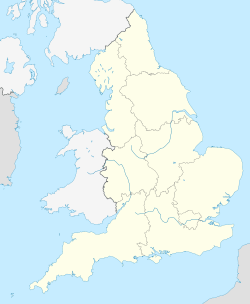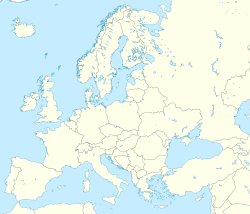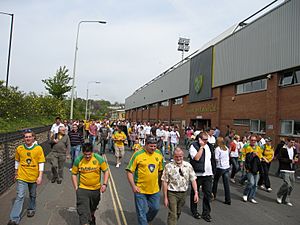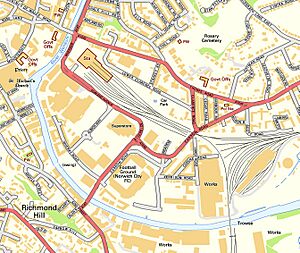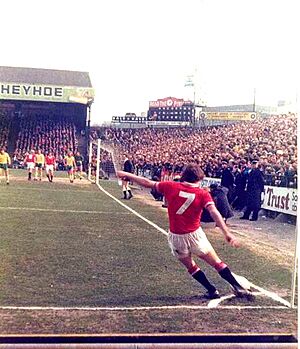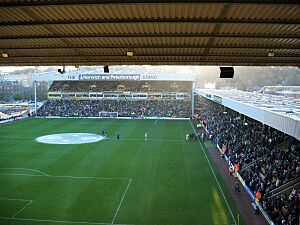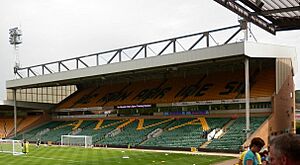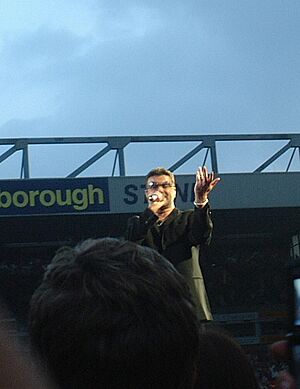Carrow Road facts for kids
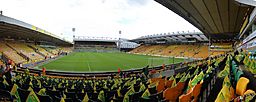
Carrow Road, looking towards the Barclay stand
|
|
| Full name | Carrow Road Stadium |
|---|---|
| Location | Norwich, Norfolk, England |
| Coordinates | 52°37′20″N 1°18′33″E / 52.62222°N 1.30917°E |
| Capacity | 27,150 |
| Record attendance | 43,984 (overall) 27,137 (all-seater) |
| Field size | 105.2 by 68 m (115.0 by 74.4 yd) |
| Surface | Desso GrassMaster |
| Construction | |
| Built | 1935 |
| Opened | 1935 |
| Expanded | 1979, 1984, 1992, 2004, 2005, 2010 |
| Tenants | |
| Norwich City (1935–present) | |
Carrow Road is a famous football stadium located in Norwich, England. It is the exciting home ground for Norwich City, a team that plays in the EFL Championship. You can find the stadium on the east side of the city, close to the Norwich railway station and the River Wensum.
Norwich City didn't always play at Carrow Road. They first played at a place called Newmarket Road. Later, they moved to a ground known as The Nest. But The Nest became too small for all the fans who wanted to watch the games.
So, the club decided to build a brand new stadium. They built Carrow Road super fast, in just 82 days! It opened on 31 August 1935. The stadium is named after the road it sits on.
Over the years, Carrow Road has been updated many times. After a big fire in 1984, one of the stands had to be rebuilt. Since 1992, all fans have had a seat, as standing areas were changed. The stadium can now hold 27,359 people.
The biggest crowd at Carrow Road since it became all-seater was 27,137 fans. This happened during a Premier League match against Newcastle United on 2 April 2016. Back when fans could stand, a huge crowd of 43,984 watched an FA Cup game in 1963.
Carrow Road isn't just for football. It has also hosted international matches for younger players. Famous musicians like Elton John and George Michael have performed concerts there too. The stadium even has places to eat and a Holiday Inn hotel where you can stay and see the pitch!
Contents
History of Carrow Road
How the Stadium Started
Norwich City Football Club played at Newmarket Road from 1902 to 1908. Their biggest crowd there was 10,366 people. After a disagreement about renting Newmarket Road, the club moved in 1908. Their new home was an old chalk pit, which they called The Nest. It got its name from the club's nickname, "The Canaries."
By the 1930s, The Nest was too small for the growing number of fans. The biggest crowd at The Nest was 25,037 in 1935. The club couldn't make The Nest bigger because of where it was built. There were also safety worries. One part of the pitch even sank by 30 feet!
The Football Association (FA) told the club on 15 May 1935 that The Nest was no longer safe for big crowds. Norwich City needed a new home fast, with the new season just weeks away. They found a new spot about half a mile from The Nest. It was the Boulton Paul Sports Ground on Carrow Road, owned by J. & J. Colman.
Building the New Stadium
The new stadium got its name from Carrow Road, which surrounds it on three sides. The River Wensum forms the fourth side. The name "Carrow" comes from the old Carrow Abbey that used to be by the river.
In 1935, Colman's offered Norwich City a 20-year lease for the land. Building the new stadium started very quickly. Work began on 11 June, just ten days after the site was bought.
They even used materials from the old "Chicken Run" section of The Nest. The rubble helped create a bank at the river end of the new ground. Most of the stands and terraces were built by 17 August. After only 82 days, the stadium opened on 31 August 1935. The first game was a Second Division match against West Ham United.
The stadium could hold 35,000 people at first, with 5,000 seats under cover. Norwich won the first game 4–3, and 29,779 fans attended. This was a new record for a home game. Norwich's Duggie Lochhead scored the first goal at the new stadium.
Club officials were amazed by how fast it was built. They called it "the largest construction job in the city since the building of Norwich Castle." An old photo from 1935 shows open terraces and a covered stand. This stand had a Colman's Mustard ad painted on its roof, only visible from the air. Colman's has been linked to the club for a long time.
Captain Evelyn Barclay, a club vice-president, paid for the covered terrace. This part of the stadium is still called the Barclay end today. By 1937, the stadium could hold 38,000 fans. In 1938, King George VI even watched a game there. This was the first time a king had watched a Second Division match!
Stadium Upgrades Over Time
In 1956, floodlights were put up at the stadium. This cost £9,000 and almost made the club go broke. But Norwich's great run in the 1958–59 FA Cup saved them. They were a Third Division club but reached the semi-finals. This success brought in enough money to cover the South Stand.
In 1963, the record attendance for Carrow Road was set: 43,984 fans. They watched an FA Cup match against Leicester City. Soon after, the South Stand got its cover.
After a stadium disaster in 1971, new safety rules came in. This meant Carrow Road's capacity was cut to about 20,000. Seats started to replace standing areas. By 1979, the stadium could hold 28,392 people, with 12,675 seats.
A fire in 1984 destroyed part of one stand. This led to a new City Stand being built by 1987. The club chairman at the time said visiting the new stand was like "going to the theatre."
After another disaster in 1989, all stadiums in England had to become all-seater. Carrow Road was fully converted by 1992. In 2003, the South Stand was replaced by the new 8,000-seat Jarrold Stand. In 2010, the stadium's capacity was increased from 26,018 to 27,000 by adding more seats.
New Pitch and 80th Birthday
In 2004, £700,000 was spent to make the pitch better. The old grass pitch was replaced with a special Desso GrassMaster surface. This mix of artificial and real grass makes sure the pitch always looks great for TV. The under-soil heating system can melt snow and ice in just eight hours.
To celebrate the stadium's 80th birthday on 31 August 2015, a special rematch was played. It was against West Ham, just like the very first game. Fans could even put their names on their seats.
The Stands of Carrow Road
Carrow Road has four main stands. They are the Regency Security Stand, The Barclay, the Geoffrey Watling City Stand, and The Jarrold Stand.
| Stand | Capacity |
|---|---|
| Regency Security Stand | 6,239 |
| The Barclay | 6,267 |
| Geoffrey Watling City Stand | 4,338 |
| The Jarrold Stand | 8,434 |
| Joma Community | 1,708 |
| Other | 249 |
Regency Security Stand
This stand is closest to the River Wensum. Fans still sometimes call it the "River End." The old stand was knocked down in 1979 and a new two-tiered one was finished that same year. It was later named the Norwich & Peterborough Stand after a sponsor. In 2010, 160 more seats were added, making its capacity 6,239. It is now called the Regency Security Stand.
The Barclay
The Barclay stand is named after Captain Evelyn Barclay. He was a club vice-president who paid for the roof of the original stand. That first stand was built in 1937. It was replaced in 1992 with a new two-tier stand, similar to the River End. This was done to meet new safety rules. The Barclay can now hold 6,267 fans.
Geoffrey Watling City Stand
A big fire on 25 October 1984 destroyed the old City Stand. The new single-tiered Geoffrey Watling City Stand was built to replace it. The fire was thought to be caused by an electric heater left on overnight.
The new City Stand cost £1.7 million to build. It was first used on 30 August 1986 for a game against Southampton. The Duchess of Kent officially opened it in 1987. The stand was renamed to honor Norwich City president Geoffrey Watling after he passed away in 2004. This stand has the fewest seats, with a capacity of 4,338. It also has special boxes for directors and the press. The corner where The Barclay meets this stand is called "The Snakepit" by fans.
The Jarrold Stand
The Jarrold Stand is where the old South Stand used to be. It opened in parts in early 2004. Ken Brown, a former manager, officially opened it.
From 2004 to 2016, and again from the 2025-26 season, the stand has been sponsored by a local department store called Jarrolds. It's a single-tiered stand that can hold 8,434 people. In 2016, a large rotating screen was put between the Jarrold and Barclay stands. This screen shows videos to fans. It's the only rotating big screen in world football!
The corner between the Jarrold and Regency Security stands is called the Joma Community Stand. It was built in 2005 and can seat up to 1,708 fans. It also has great facilities for disabled supporters.
Visiting Fan Area
Fans visiting from other teams sit in the part of the South Stand closest to The Barclay. This area is known for having good facilities and a great view of the game. Usually, about 2,500 visiting fans can sit here. If you sit at the very back, you can even see parts of the city!
Other Cool Things at Carrow Road
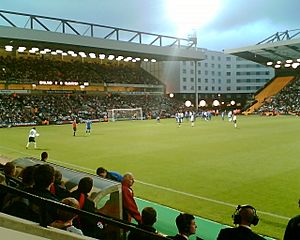
There's a Holiday Inn hotel in the corner between The Barclay and the Jarrold Stand. It opened in 2007 and has six floors and 150 rooms. Some rooms even have views of the football pitch!
Delia's Canary Catering handles all the food at Carrow Road. This company is part of Norwich City Football Club. The famous cook Delia Smith took charge of the catering in 1999.
You can find different places to eat at the stadium. "Yellows American Bar & Grill" is an American-style diner. "Delia's Restaurant and Bar" offers more dining options. "The Gunn Club" is another food area, named after former player and manager Bryan Gunn. There are also many other rooms for events, named after players or sponsors like Lotus Cars.
Getting to Carrow Road
Carrow Road is about a ten-minute walk from Norwich railway station. This station connects to Liverpool Street station in London. While you can't park on the roads right around the stadium, there's a park-and-ride service. This lets visitors take a bus to the ground from outside the city center.
Future Plans for More Seats
Norwich City is a very popular club. They have a limit of 22,000 season tickets, and there's a waiting list! The stadium is almost always full for home games. In the 2013–14 season, 99.95% of seats were filled. This was one of the highest rates in the Premier League.
Because of this, the club often talks about making the stadium bigger. The Geoffrey Watling City Stand is built so that another level could be added. In 2011, the club chairman said they wanted to add about 8,000 more seats. He thought the Geoffrey Watling stand was the best place to expand.
In 2012, a study looked at how much it would cost to make the stadium much bigger. It found that adding 7,000 seats would cost £20 million. The club decided they would only expand the stadium when Norwich City is a regular team in the Premier League.
Other Events at Carrow Road
International Football Games
Carrow Road has never hosted a game for the main England team. However, the England under-21 team has played there five times. Their first game was in 1983 against Denmark, which England won 4–1.
In 2007, England under-21s beat Slovakia 5–0 in front of over 20,000 fans. In 2010, a record 25,749 fans watched England beat Romania 2–1. The England U21s also won 1–0 against Serbia at Carrow Road in 2012.
The England women's team has also played at the stadium four times. In 2002, over 8,000 fans watched them lose 1–0 to Nigeria. In 2006, they beat Iceland 1–0. In February 2022, 14,284 fans saw England draw 0-0 with Spain. Local player Lauren Hemp played in that game. Hemp and the Lionesses returned in July 2024, winning 2-1 against the Republic of Ireland with 23,003 fans watching.
1986 Women's FA Cup Final
Before 2015, the finals of the Women's FA Cup were held at different stadiums. By chance, in 1986, Carrow Road was chosen to host the final. Even better, Norwich reached the final that year! They beat Doncaster Belles 4-3 in an exciting match.
Music Concerts
Carrow Road sometimes hosts big music concerts. Status Quo played there in 1997. Elton John performed in 2005, with Lulu as a special guest. George Michael had a concert there on 12 June 2007, supported by Sophie Ellis-Bextor. Rod Stewart also performed in June 2011.
Both the Elton John and George Michael concerts attracted over 20,000 people. The club hopes to have more big concerts every summer. Take That performed at the stadium in 2017, 2019, and 2024. In summer 2022, The Killers and Elton John both performed. Arctic Monkeys played there on 7 June 2023.
Carrow Road Records
- Highest attendance: 43,984, Norwich City 0–2 Leicester City, FA Cup sixth round, 30 March 1963.
- Highest attendance (all-seater): 27,137, Norwich City 3–2 Newcastle United, 2015–16 Premier League, 2 April 2016.
- Biggest win: 8 goals. Norwich City 8–0 Walsall, 29 December 1951. Also, Norwich City 8–0 Sutton United, 28 January 1989.
- Biggest loss: 6 goals. Norwich City 1–7 Colchester United, 8 August 2009.
- Most goals in one game: 9 goals (happened several times). Most recently, Norwich City 4–5 Liverpool, 23 January 2016.
- Fastest goal from kick-off: Victor Johnson, 10 seconds.
See also
 In Spanish: Carrow Road para niños
In Spanish: Carrow Road para niños
- Lists of stadiums
- List of football stadiums in England


